Evidence of Multi-Source Data Fusion on the Relationship between the Specific Urban Built Environment and Urban Vitality in Shenzhen
Abstract
1. Introduction
2. Literature Review
2.1. Urban Vitality
2.2. Urban Vitality and Urban Built Environment
3. Materials
3.1. Research Scope and Spatial-Temporal Analysis Unit
3.2. Data Sources
3.3. Measurements
3.3.1. Vitality Measurements
3.3.2. Measurement of Urban Built Environment
4. Modeling Approach
4.1. Ordinary Least Squares Model
4.2. Global Moran’s I
4.3. Spatial Lag Multiple Regression Model
5. Results and Analysis
5.1. Spatial Patternning of Urban Vitality
5.2. Regression Model Outcomes
5.3. GWR Results
6. Discussion
6.1. Research Novelty: Reconstruct Definition of Urban Vitality and Establish Examine Model
6.2. Contribution: Finding of Positive and Negative Factor to Urban Vitality
6.3. Significance: Diverse Strategies to Develop Built Environment for Central Districts and Periphery Districts
7. Conclusions
Author Contributions
Funding
Institutional Review Board Statement
Informed Consent Statement
Data Availability Statement
Acknowledgments
Conflicts of Interest
References
- Li, S.; Wu, C.; Lin, Y.; Li, Z.; Du, Q. Urban Morphology Promotes Urban Vibrancy from the Spatiotemporal and Synergetic Perspectives: A Case Study Using Multisource Data in Shenzhen, China. Sustainability 2020, 12, 4829. [Google Scholar] [CrossRef]
- Chen, M.; Liu, W.; Lu, D.; Chen, H.; Ye, C. Progress of China’s new-type urbanization construction since 2014: A preliminary assessment. Cities 2018, 78, 180–193. [Google Scholar] [CrossRef]
- Bowen, K.J.; Cradock-Henry, N.A.; Koch, F.; Patterson, J.; Häyhä, T.; Vogt, J.; Barbi, F. Implementing the “Sustainable Development Goals”: Towards addressing three key governance challenges—Collective action, trade-offs, and accountability. Curr. Opin. Environ. Sustain. 2017, 26–27, 90–96. [Google Scholar] [CrossRef]
- Ye, Y.; Li, D.; Liu, X. How block density and typology affect urban vitality: An exploratory analysis in Shenzhen, China. Urban Geogr. 2017, 39, 631–652. [Google Scholar] [CrossRef]
- Xu, Y.; Chen, X. The spatial vitality and spatial environments of urban underground space (UUS) in metro area based on the spatiotemporal analysis. Tunn. Undergr. Space Technol. Inc. Trenchless Technol. Res. 2022, 123, 104401. [Google Scholar] [CrossRef]
- Xia, C.; Yeh, A.G.-O.; Zhang, A. Analyzing spatial relationships between urban land use intensity and urban vitality at street block level: A case study of five Chinese megacities. Landsc. Urban Plan. 2020, 193, 103669. [Google Scholar] [CrossRef]
- Jin, X.; Long, Y.; Sun, W.; Lu, Y.; Yang, X.; Tang, J. Evaluating cities’ vitality and identifying ghost cities in China with emerging geographical data. Cities 2017, 63, 98–109. [Google Scholar] [CrossRef]
- Chen, W.; Wu, A.N.; Biljecki, F. Classification of urban morphology with deep learning: Application on urban vitality. Comput. Environ. Urban Syst. 2021, 90, 101706. [Google Scholar] [CrossRef]
- Liu, K.; Yin, L.; Lu, F.; Mou, N. Visualizing and exploring POI configurations of urban regions on POI-type semantic space. Cities 2020, 99, 102610. [Google Scholar] [CrossRef]
- Yang, S.; van Oostrum, M. The self-governing redevelopment approach of Maquanying: Incremental socio-spatial transformation in one of Beijing’s urban villages. Habitat Int. 2020, 104, 102235. [Google Scholar] [CrossRef]
- Ramyar, R. Nudging spirituality in environmental behavior. Cities 2021, 109, 103030. [Google Scholar] [CrossRef]
- Liu, G.; Wei, L.; Gu, J.; Zhou, T.; Liu, Y. Benefit distribution in urban renewal from the perspectives of efficiency and fairness: A game theoretical model and the government’s role in China. Cities 2020, 96, 102422. [Google Scholar] [CrossRef]
- Figueiredo, Y.D.d.S.; Prim, M.A.; Dandolini, G.A. Urban regeneration in the light of social innovation: A systematic integrative literature review. Land Use Policy 2022, 113, 105873. [Google Scholar] [CrossRef]
- Sun, X.; Wang, L.; Wang, F.; Soltani, S. Behaviors of seniors and impact of spatial form in small-scale public spaces in Chinese old city zones. Cities 2020, 107, 102894. [Google Scholar] [CrossRef]
- Liu, R.; Guo, H.; Liu, R.; Wang, H.; Tang, D.; Deng, Z. Structural design and optimization of large cable–rib tension deployable antenna structure with dynamic constraint. Acta Astronaut. 2018, 151, 160–172. [Google Scholar] [CrossRef]
- Liu, R.; Wong, T.-C. Urban village redevelopment in Beijing: The state-dominated formalization of informal housing. Cities 2018, 72, 160–172. [Google Scholar] [CrossRef]
- van Oostrum, M. Urbanizing villages: Informal morphologies in Shenzhen’s urban periphery. J. Urban Des. 2018, 23, 732–748. [Google Scholar] [CrossRef]
- Davis, H.; Brown, M. Resilient Urban Morphologies and Grassroots Economic Development: Preliminary Results of Fieldwork in Guangzhou, China; International Seminar on Urban Form (ISUF): Belgrade, Serbia, 2011; 29p. [Google Scholar]
- Hao, P.; Geertman, S.; Hooimeijer, P.; Sliuzas, R. Spatial Analyses of the Urban Village Development Process in Shenzhen, China. Int. J. Urban Reg. Res. 2013, 37, 2177–2197. [Google Scholar] [CrossRef]
- Wu, F.; Li, L.-H.; Han, S. Social Sustainability and Redevelopment of Urban Villages in China: A Case Study of Guangzhou. Sustainability 2018, 10, 2116. [Google Scholar] [CrossRef]
- Pan, W.; Du, J. Towards sustainable urban transition: A critical review of strategies and policies of urban village renewal in Shenzhen, China. Land Use Policy 2021, 111, 105744. [Google Scholar] [CrossRef]
- Conzen, M.R.G. Alnwick, Northumberland: A Study in Town-Plan Analysis; Transactions and Papers (Institute of British Geographers); Wiley: Hoboken, NJ, USA, 1960; Volume 27, p. iii+ix-xi+1+3-122. [Google Scholar] [CrossRef]
- Paumier, C. Creating a Vibrant City Center; Urban Land Institute: Washington DC, USA, 2004. [Google Scholar]
- Yang, J.; Cao, J.; Zhou, Y. Elaborating non-linear associations and synergies of subway access and land uses with urban vitality in Shenzhen. Transp. Res. Part A Policy Pract. 2021, 144, 74–88. [Google Scholar] [CrossRef]
- Talpur, M.A.H.; Napiah, M.; Chandio, I.A.; Qureshi, T.A.; Khahro, S.H. Development of a Regional Transport Policy Support System for Rural Planning Agencies in Developing World. Procedia Eng. 2014, 77, 2–10. [Google Scholar] [CrossRef]
- Wirth, L. Urbanism as a Way of Life. Am. J. Sociol. 1938, 44, 217913. [Google Scholar] [CrossRef]
- Jacobs, J. The Death and Life of Great American Cities; Random House: New York, NY, USA, 1961. [Google Scholar]
- Montgomery, J. Making a city: Urbanity, vitality and urban design. J. Urban Des. 1998, 3, 93–116. [Google Scholar] [CrossRef]
- Delafons, J.J.C. The New Urbanism: Toward an Architecture of Community; McGraw-Hill: New York, NY, USA, 1994; Volume 11, pp. 342–343. [Google Scholar]
- Chung, H.; Lee, J. Community Cultural Resources as Sustainable Development Enablers: A Case Study on Bukjeong Village in Korea compared with Naoshima Island in Japan. Sustainability 2019, 11, 1401. [Google Scholar] [CrossRef]
- Gong, P.; Chen, B.; Li, X.; Liu, H.; Wang, J.; Bai, Y.; Chen, J.; Chen, X.; Fang, L.; Feng, S.; et al. Mapping essential urban land use categories in China (EULUC-China): Preliminary results for 2018. Sci. Bull. 2020, 65, 182–187. [Google Scholar] [CrossRef]
- Chen, B.; Tu, Y.; Song, Y.; Theobald, D.M.; Zhang, T.; Ren, Z.; Li, X.; Yang, J.; Wang, J.; Wang, X.; et al. Mapping essential urban land use categories with open big data: Results for five metropolitan areas in the United States of America. ISPRS J. Photogramm. Remote Sens. 2021, 178, 203–218. [Google Scholar] [CrossRef]
- Ying, L.; Kang, W. Simulating Block-Level Urban Expansion for National Wide Cities. Sustainability 2017, 9, 879. [Google Scholar] [CrossRef]
- Chen, Z.; Dong, B.; Pei, Q.; Zhang, Z. The impacts of urban vitality and urban density on innovation: Evidence from China’s Greater Bay Area. Habitat Int. 2022, 119, 102490. [Google Scholar] [CrossRef]
- Yue, W.; Chen, Y.; Thy, P.T.M.; Fan, P.; Liu, Y.; Zhang, W. Identifying urban vitality in metropolitan areas of developing countries from a comparative perspective: Ho Chi Minh City versus Shanghai. Sustain. Cities Soc. 2021, 65, 102609. [Google Scholar] [CrossRef]
- Williams, S.; Xu, W.; Tan, S.B.; Foster, M.J.; Chen, C. Ghost cities of China: Identifying urban vacancy through social media data. Cities 2019, 94, 275–285. [Google Scholar] [CrossRef]
- Meng, Y.; Xing, H. Exploring the relationship between landscape characteristics and urban vibrancy: A case study using morphology and review data. Cities 2019, 95, 102389. [Google Scholar] [CrossRef]
- Tu, W.; Zhu, T.; Xia, J.; Zhou, Y.; Lai, Y.; Jiang, J.; Li, Q. Portraying the spatial dynamics of urban vibrancy using multisource urban big data. Comput. Environ. Urban Syst. 2020, 80, 101428. [Google Scholar] [CrossRef]
- Lan, F.; Gong, X.; Da, H.; Wen, H. How do population inflow and social infrastructure affect urban vitality? Evidence from 35 large- and medium-sized cities in China. Cities 2020, 100, 102454. [Google Scholar] [CrossRef]
- Hu, S.; Xu, Y.; Wu, L.; Wu, X.; Wang, R.; Zhang, Z.; Lu, R.; Mao, W. A framework to detect and understand thematic places of a city using geospatial data. Cities 2021, 109, 103012. [Google Scholar] [CrossRef]
- Yue, Y.; Zhuang, Y.; Yeh, A.G.O.; Xie, J.-Y.; Ma, C.-L.; Li, Q.-Q. Measurements of POI-based mixed use and their relationships with neighbourhood vibrancy. Int. J. Geogr. Inf. Sci. 2016, 31, 658–675. [Google Scholar] [CrossRef]
- Wu, J.; Lu, Y.; Gao, H.; Wang, M. Cultivating historical heritage area vitality using urban morphology approach based on big data and machine learning. Comput. Environ. Urban Syst. 2022, 91, 101716. [Google Scholar] [CrossRef]
- Ferreira, J.; Ferreira, C.; Bos, E. Spaces of consumption, connection, and community: Exploring the role of the coffee shop in urban lives. Geoforum 2021, 119, 21–29. [Google Scholar] [CrossRef]
- Braun, L.M.; Malizia, E. Downtown vibrancy influences public health and safety outcomes in urban counties. J. Transp. Health 2015, 2, 540–548. [Google Scholar] [CrossRef]
- Zhang, A.; Li, W.; Wu, J.; Lin, J.; Chu, J.; Xia, C.J.E. How can the urban landscape affect urban vitality at the street block level? A case study of 15 metropolises in China. Environ. Plan. B 2021, 48, 1245–1262. [Google Scholar] [CrossRef]
- Pan, W.; Du, J. Impacts of urban morphological characteristics on nocturnal outdoor lighting environment in cities: An empirical investigation in Shenzhen. Build. Environ. 2021, 192, 107587. [Google Scholar] [CrossRef]
- Li, X.; Li, Y.; Jia, T.; Zhou, L.; Hijazi, I.H. The six dimensions of built environment on urban vitality: Fusion evidence from multi-source data. Cities 2022, 121, 103482. [Google Scholar] [CrossRef]
- Martino, N.; Girling, C.; Lu, Y. Urban form and livability: Socioeconomic and built environment indicators. Build. Cities 2021, 2, 220–243. [Google Scholar] [CrossRef]
- Dziauddin, M.F. Estimating land value uplift around light rail transit stations in Greater Kuala Lumpur: An empirical study based on geographically weighted regression (GWR). Res. Transp. Econ. 2019, 74, 10–20. [Google Scholar] [CrossRef]
- Delclòs-Alió, X.; Gutiérrez, A.; Miralles-Guasch, C. The urban vitality conditions of Jane Jacobs in Barcelona: Residential and smartphone-based tracking measurements of the built environment in a Mediterranean metropolis. Cities 2019, 86, 220–228. [Google Scholar] [CrossRef]
- Wu, C.; Ye, X.; Ren, F.; Du, Q. Check-in behaviour and spatio-temporal vibrancy: An exploratory analysis in Shenzhen, China. Cities 2018, 77, 104–116. [Google Scholar] [CrossRef]
- Wang, K.; Yuan, Y.; Chen, M.; Wang, D. A POIs based method for determining spatial distribution of urban fire risk. Process Saf. Environ. Prot. 2021, 154, 447–457. [Google Scholar] [CrossRef]
- Yuan, N.J.; Zhang, F.; Lian, D.; Zheng, K.; Yu, S.; Xie, X. We know how you live: Exploring the spectrum of urban lifestyles. In Proceedings of the COSN ’13, Boston, MA, USA, 7–8 October 2013. [Google Scholar]
- Sulis, P.; Manley, E.; Zhong, C.; Batty, M. Using mobility data as proxy for measuring urban vitality. J. Spat. Inf. Sci. 2018, 16, 384. [Google Scholar] [CrossRef]
- Chen, T.; Hui, E.C.M.; Wu, J.; Lang, W.; Li, X. Identifying urban spatial structure and urban vibrancy in highly dense cities using georeferenced social media data. Habitat Int. 2019, 89, 102005. [Google Scholar] [CrossRef]
- Guo, X.; Yang, Y.; Cheng, Z.; Wu, Q.; Li, C.; Lo, T.; Chen, F. Spatial social interaction: An explanatory framework of urban space vitality and its preliminary verification. Cities 2022, 121, 103487. [Google Scholar] [CrossRef]
- Currid, E. Symposium Introduction-Art and Economic Development: New Directions for the Growth of Cities and Regions. J. Plan. Educ. Res. 2010, 29, 257–261. [Google Scholar] [CrossRef]
- Montalto, V.; Tacao Moura, C.J.; Langedijk, S.; Saisana, M. Culture counts: An empirical approach to measure the cultural and creative vitality of European cities. Cities 2019, 89, 167–185. [Google Scholar] [CrossRef]
- Shannon, C.E. A mathematical theory of communication. Bell Syst. Tech. J. 1948, 27, 379–423. [Google Scholar] [CrossRef]
- Lai, Y.; Chan, E.H.W.; Choy, L. Village-led land development under state-led institutional arrangements in urbanising China: The case of Shenzhen. Urban Stud. 2016, 54, 1736–1759. [Google Scholar] [CrossRef]
- Wang, Y.P. Urban Villages, Their Redevelopment and Implications for Inequality and Integration. In Urban Inequality and Segregation in Europe and China: Towards a New Dialogue; Pryce, G., Wang, Y.P., Chen, Y., Shan, J., Wei, H., Eds.; Springer International Publishing: Cham, Stwitzerland, 2021; pp. 99–120. [Google Scholar]
- Talpur, M.A.H.; Khahro, S.H.; Ali, T.H.; Waseem, H.B.; Napiah, M. Computing travel impendences using trip generation regression model: A phenomenon of travel decision-making process of rural households. Environ. Dev. Sustain. 2022. [Google Scholar] [CrossRef]
- Wu, J.; Ta, N.; Song, Y.; Lin, J.; Chai, Y. Urban form breeds neighborhood vibrancy: A case study using a GPS-based activity survey in suburban Beijing. Cities 2018, 74, 100–108. [Google Scholar] [CrossRef]
- Im, H.N.; Choi, C.G. The hidden side of the entropy-based land-use mix index: Clarifying the relationship between pedestrian volume and land-use mix. Urban Stud. 2018, 56, 1865–1881. [Google Scholar] [CrossRef]
- Guo, X.; Chen, H.; Yang, X. An Evaluation of Street Dynamic Vitality and Its Influential Factors Based on Multi-Source Big Data. ISPRS Int. J. Geo-Inf. 2021, 10, 143. [Google Scholar] [CrossRef]
- Koçak Güngör, M.; Bostancı, B.; Yılmaz Bakır, N.; Doğan, U. Investigation of Urban Design Approaches in Renewal Areas with Hybrid Decision Model. Sustainability 2022, 14, 10543. [Google Scholar] [CrossRef]
- Elshater, A.; Abusaada, H.; Tarek, M.; Afifi, S. Designing the socio-spatial context: Urban infill, liveability, and conviviality. Built Environ. 2022, 48, 341–363. [Google Scholar] [CrossRef]
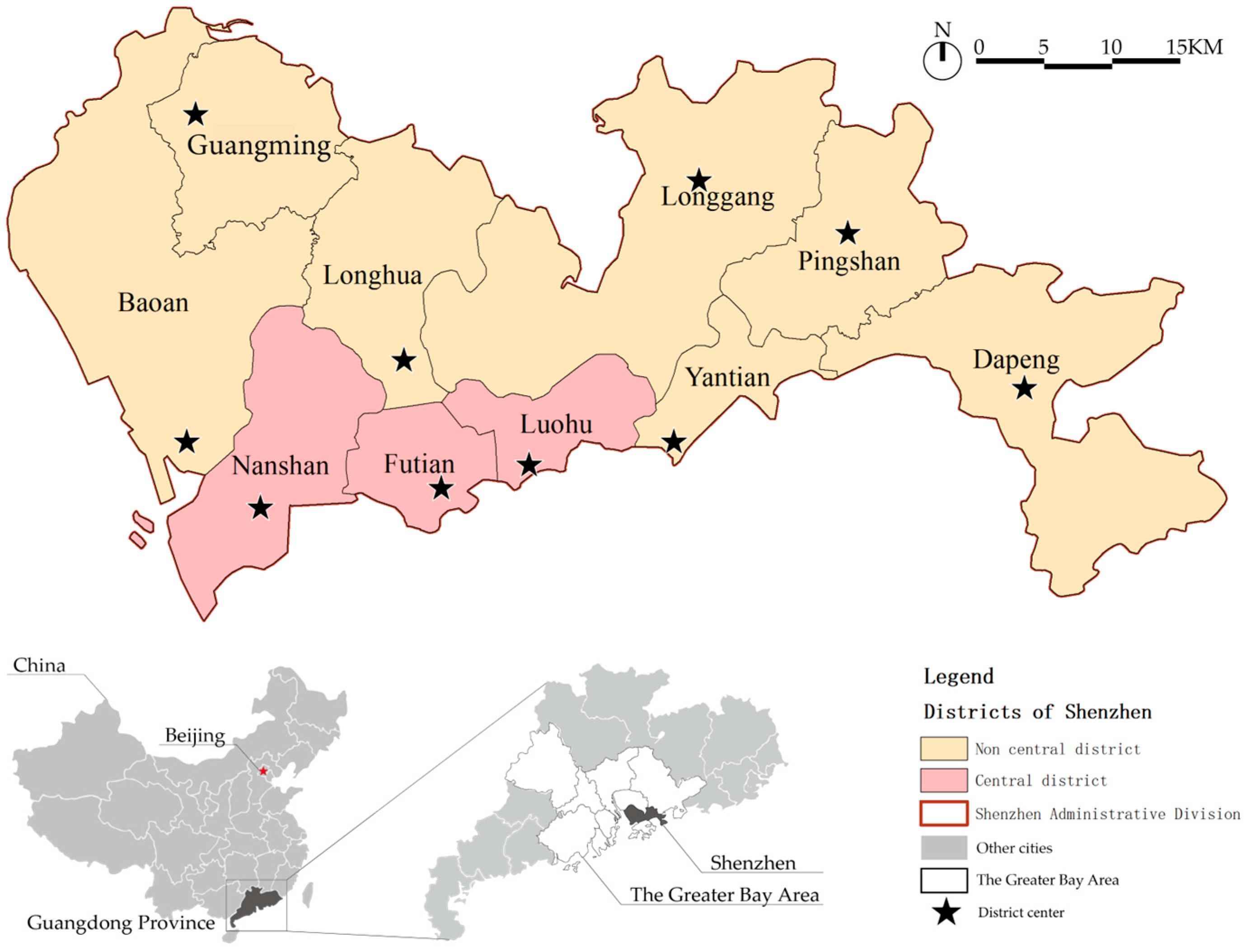
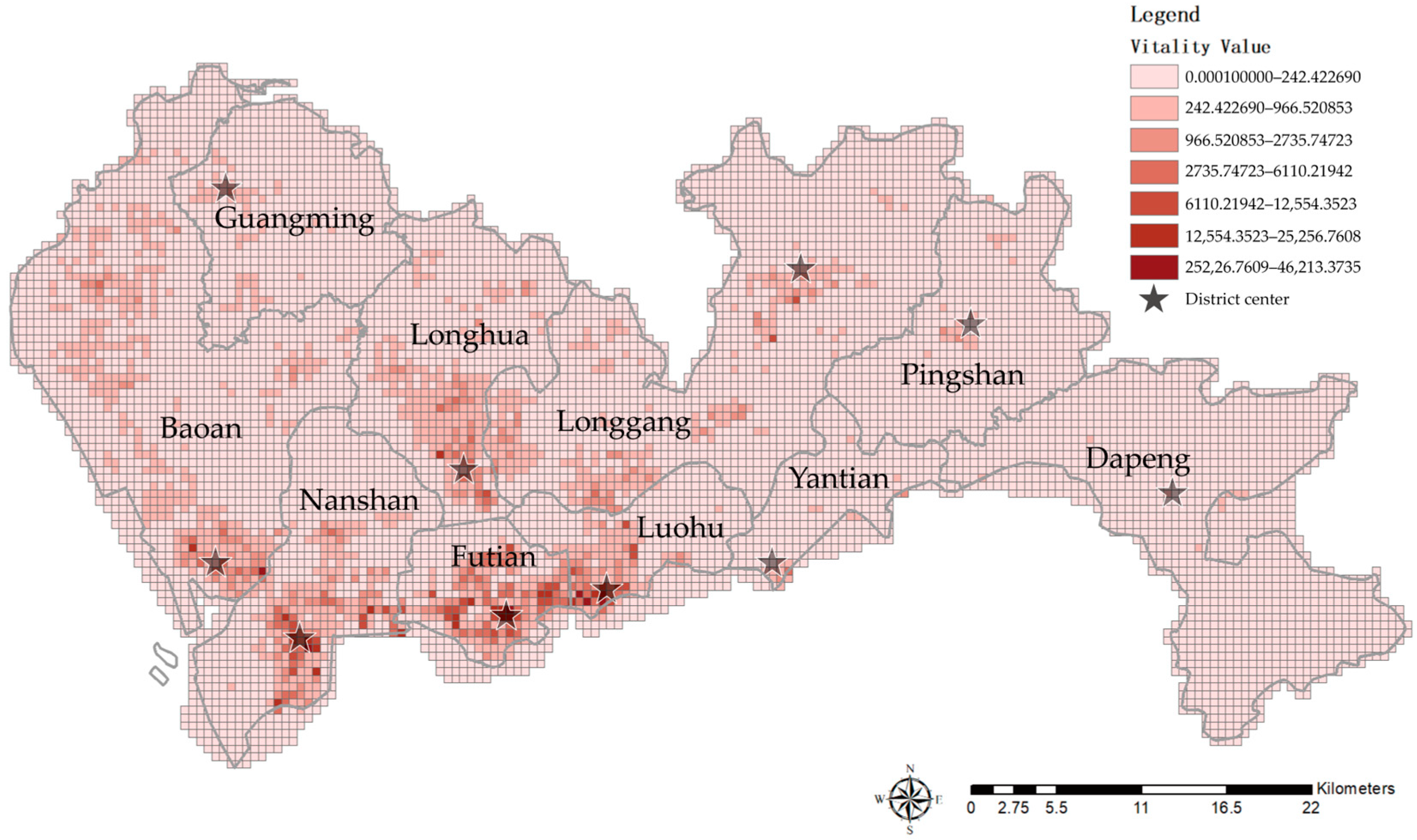


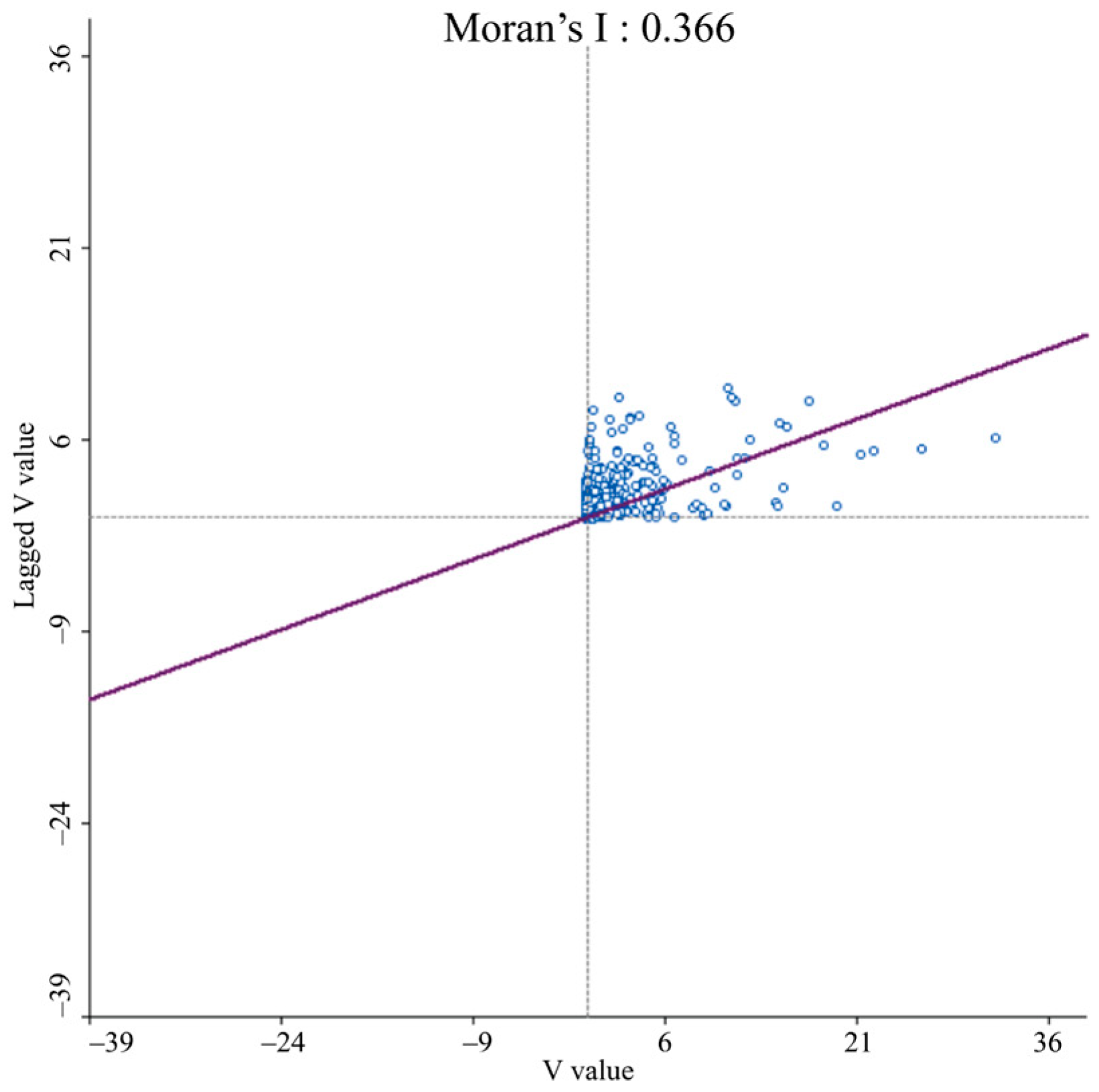
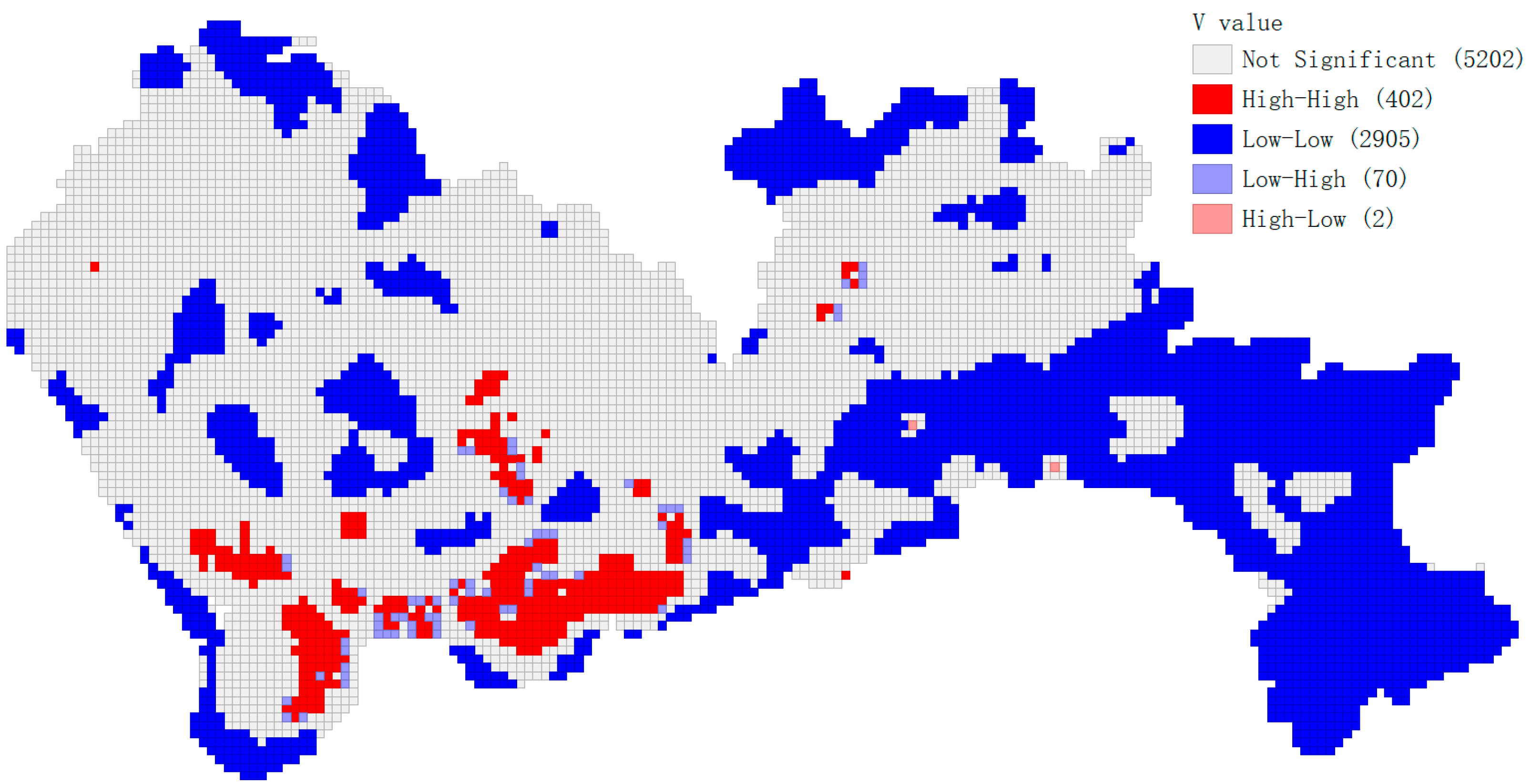

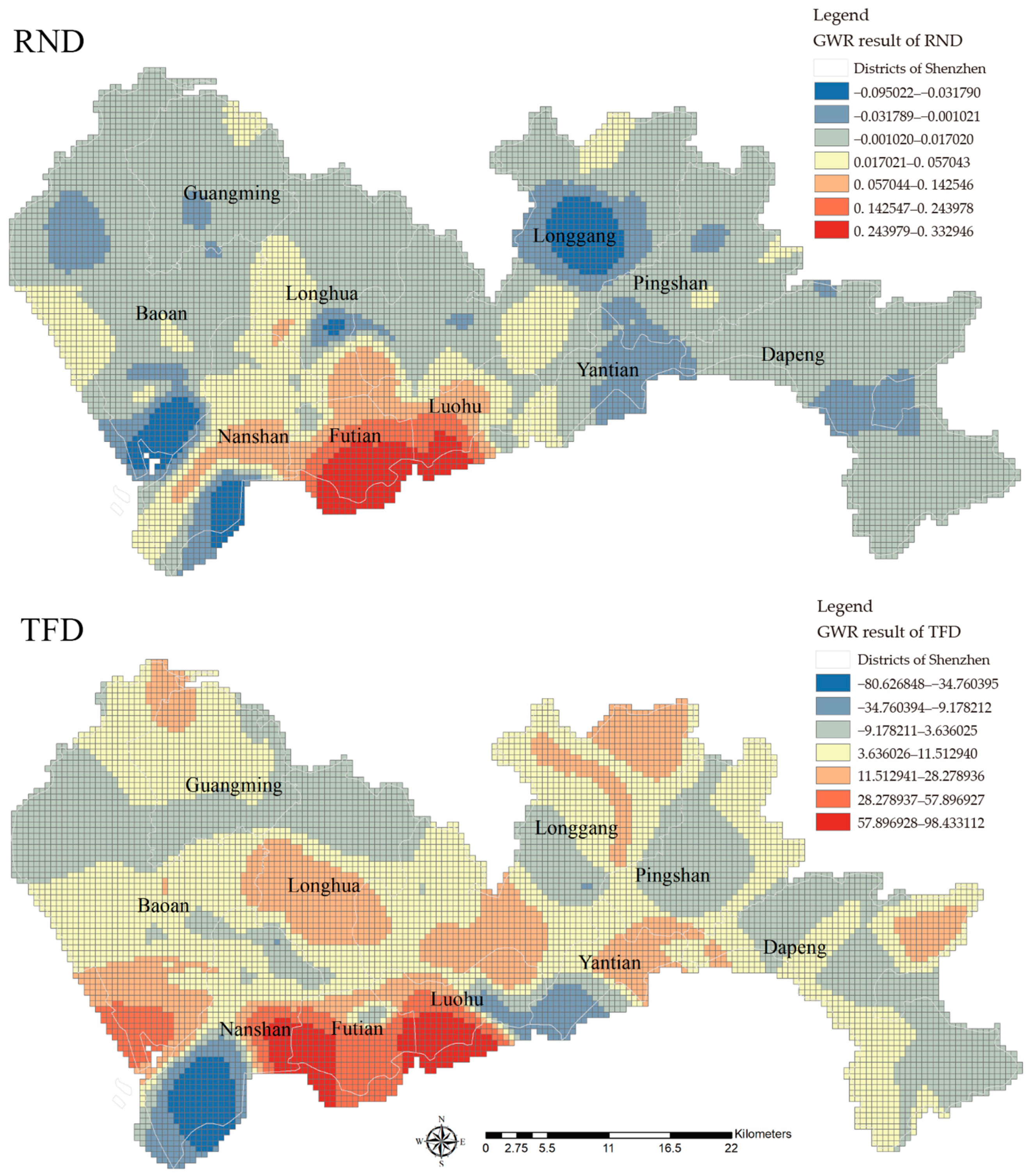
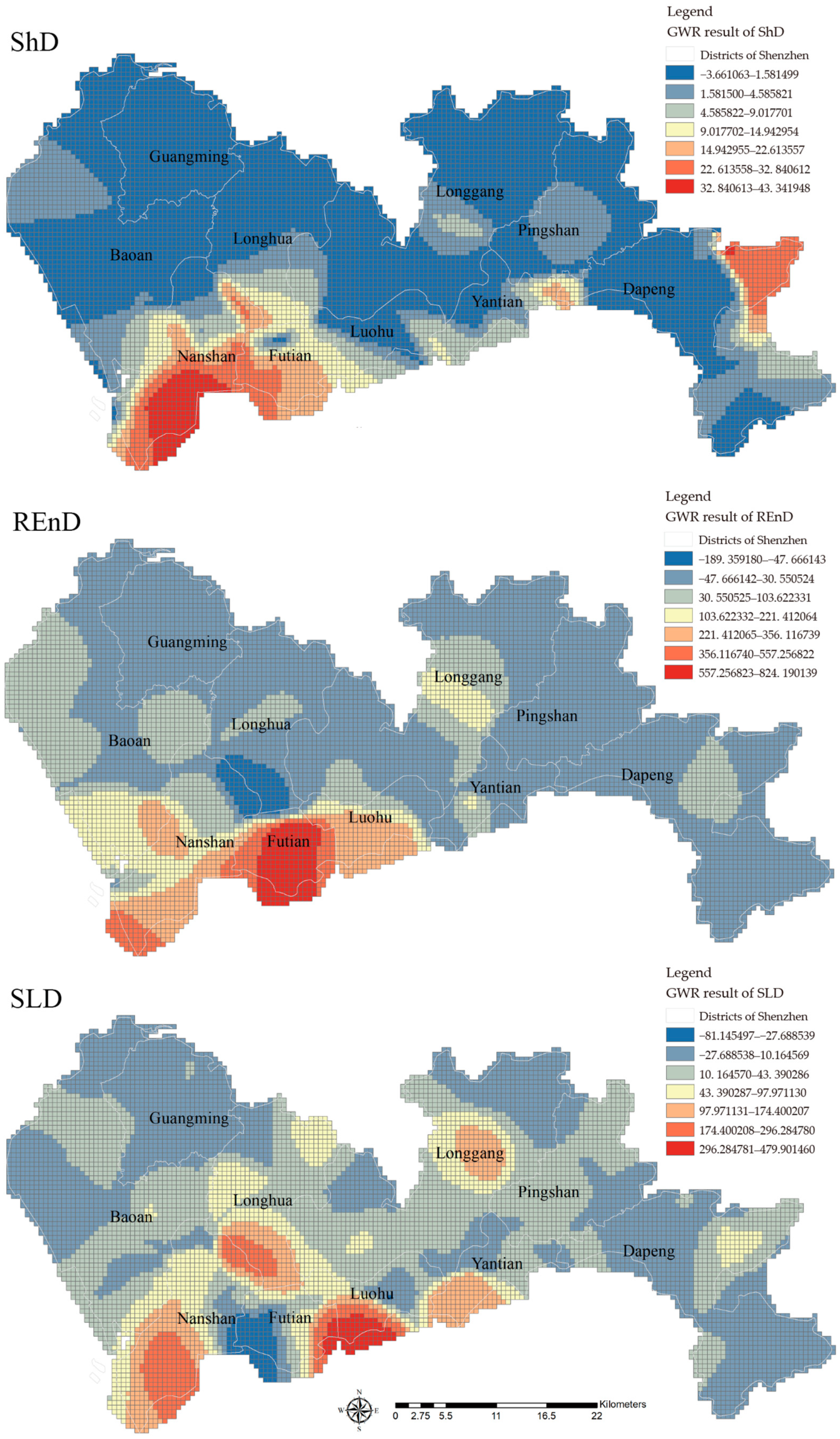

| Data | Data Source | Data Period |
|---|---|---|
| POI data | Amap. Available at: https://lbs.amap.com/ (accessed on 26 January 2022) | 2021 |
| Urban form data | OpenStreetMap. Available at: https://www.openstreetmap.org (accessed on 15 February 2022) | 2022 |
| Population | Shenzhen Planning and Natural Resources Bureau | 2022 |
| Comments data | Dianping. Available at: https://www.dianping.com/ (accessed on 21 February 2022) | 2017 |
| Shared bike data | Shenzhen Government Data Open Platform. Available at: https://opendata.sz.gov.cn/ (accessed on 15 February 2022) | 2021 |
| Landsat RS image | National Earth System Science Data Center. Available at: http://www.geodata.cn/ (accessed on 21 February 2022) | 2022 |
| Urban village data | Amap. Available at: https://lbs.amap.com/ (accessed on 26 January 2022) | 2021 |
| Component | Name | Description |
|---|---|---|
| Economic vitality | Company density | The number of companies divided by the space unit area, reflecting the distribution of enterprises |
| Comments number | The total comments number of amenities in the unit | |
| Social vitality | Population density | Population divided by space unit area, reflecting population characteristics |
| Shared bike data | Weekly average density of shared bike arrivals per hour in the unit | |
| Cultural vitality | Cultural facilities density (science/culture & education services) | Cultural facility POI density of space unit |
| Component | Variables | Description | Mean | Std. | Max | Min |
|---|---|---|---|---|---|---|
| Urban form | Road network density (RND) | The total length of roads in the space unit divided by the area of the unit | 1541.97 | 1785.70 | 15,639.50 | 0.00 |
| Transportation facilities density (TFD) | The total number of transportation facilities in a unit divided by the area of the unit | 4.65 | 9.14 | 118.00 | 0.00 | |
| Building density (BuD) | The total area of building footprints in a unit divided by the area of the unit | 363,834.56 | 607,483.34 | 5,834,529.17 | 0.00 | |
| Urban village | Distance from urban villages (DUV) | The straight-line distance from the centroid of the space unit to the nearest urban village | 0.11 | 0.13 | 0.75 | 0.00 |
| POI | Food facilities density (FoD) | The total number of food facilities in a unit divided by the area of the unit | 14.64 | 34.49 | 415.00 | 0.00 |
| Shopping facilities density (ShD) | The total number of shopping facilities in a unit divided by the area of the unit | 19.75 | 47.97 | 1112.00 | 0.00 | |
| Public service facilities density (PuSD) | The total number of public service facilities in a unit divided by the area of the unit | 10.07 | 21.14 | 236.00 | 0.00 | |
| Recreation & Entertainment density (REnD) | The total number of recreation & entertainment facilities in a unit divided by the area of the unit | 0.83 | 2.34 | 72.00 | 0.00 | |
| Residential facilities density (ReD) | The total number of residential facilities in a unit divided by the area of the unit | 3.59 | 6.99 | 164.00 | 0.00 | |
| Medical facilities density (MeD) | The total number of medical facilities in a unit divided by the area of the unit | 2.49 | 5.98 | 62.00 | 0.00 | |
| Outdoor and recreation density (ORD) | The total number of POIs in the outdoor and recreation category divided by the area of the unit | 0.47 | 2.01 | 74.00 | 0.00 | |
| Sports and leisure density (SLD) | The total number of sports and leisure in a unit divided by the area of the unit | 0.89 | 2.16 | 29.00 | 0.00 |
| Variable | Coefficient | Std. Error | t-Statistic | Probability | Model Diagnosis |
|---|---|---|---|---|---|
| CONSTANT | −74.0718 | 18.525 | −3.9985 | 0.0000 | R2 = 0.3340 Adjusted R2 = 0.3333 LogL = −72,861.6 AIC = 145,743 F = 477.683 p = 0 |
| RND | 0.0595 | 0.0091 | 6.5149 | 0.0000 | |
| TFD | 36.4748 | 2.5703 | 14.1909 | 0.0000 | |
| BuD | 0.0001 | 0.0000 | 3.8882 | 0.0001 | |
| DUV | −887.301 | 126.55 | −7.0115 | 0.0000 | |
| ShD | 4.1320 | 0.4255 | 9.7103 | 0.0000 | |
| REnD | 195.617 | 8.2414 | 23.736 | 0.0000 | |
| ReD | −45.6359 | 2.9904 | −15.2609 | 0.0000 | |
| ORD | −2.2176 | 6.4593 | −0.3433 | 0.7312 | |
| SLD | 81.0221 | 9.0196 | 8.9829 | 0.0000 |
| Variable | Coefficient | Std. Error | t-Statistic | Probability | Model Diagnosis |
|---|---|---|---|---|---|
| CONSTANT | −29.6145 | 16.9158 | −1.7507 | 0.0800 | R2 = 0.4451 LogL = −72,260.6 AIC = 144,541 p = 0 |
| RND | 0.0214 | 0.0083 | 2.5625 | 0.0104 | |
| TFD | 14.7271 | 2.3713 | 6.2107 | 0.0000 | |
| BuD | 0.0000 | 0.0000 | 0.5104 | 0.6098 | |
| DUV | −834.246 | 115.517 | −7.2218 | 0.0000 | |
| ShD | 4.7488 | 0.3890 | 12.2079 | 0.0000 | |
| REnD | 161.501 | 7.5144 | 21.4922 | 0.0000 | |
| ReD | −38.382 | 2.7266 | −14.0767 | 0.0000 | |
| SLD | 70.5386 | 8.2414 | 8.5591 | 0.0000 |
| Variable | Mean | Std | Min | Max | Model Diagnosis |
|---|---|---|---|---|---|
| RND | 0.0203 | 0.0568 | −0.0950 | 0.3329 | R2 = 0.6146 Adjusted R2 = 0.5899 LogL = −72,260.6 AIC = 141,859 |
| TFD | 8.3607 | 17.8053 | −80.6268 | 98.4331 | |
| DUV | −130.8055 | 921.8018 | −4939.5691 | 1369.5485 | |
| ShD | 4.6223 | 8.4785 | −3.6611 | 43.3419 | |
| REnD | 68.1365 | 138.6568 | −189.3592 | 824.1901 | |
| ReD | −15.8130 | 49.0429 | −269.1397 | 97.4530 | |
| SLD | 34.8054 | 64.5109 | −81.1455 | 479.9015 |
Disclaimer/Publisher’s Note: The statements, opinions and data contained in all publications are solely those of the individual author(s) and contributor(s) and not of MDPI and/or the editor(s). MDPI and/or the editor(s) disclaim responsibility for any injury to people or property resulting from any ideas, methods, instructions or products referred to in the content. |
© 2023 by the authors. Licensee MDPI, Basel, Switzerland. This article is an open access article distributed under the terms and conditions of the Creative Commons Attribution (CC BY) license (https://creativecommons.org/licenses/by/4.0/).
Share and Cite
Zhang, P.; Zhang, T.; Fukuda, H.; Ma, M. Evidence of Multi-Source Data Fusion on the Relationship between the Specific Urban Built Environment and Urban Vitality in Shenzhen. Sustainability 2023, 15, 6869. https://doi.org/10.3390/su15086869
Zhang P, Zhang T, Fukuda H, Ma M. Evidence of Multi-Source Data Fusion on the Relationship between the Specific Urban Built Environment and Urban Vitality in Shenzhen. Sustainability. 2023; 15(8):6869. https://doi.org/10.3390/su15086869
Chicago/Turabian StyleZhang, Pei, Tao Zhang, Hiroatsu Fukuda, and Moheng Ma. 2023. "Evidence of Multi-Source Data Fusion on the Relationship between the Specific Urban Built Environment and Urban Vitality in Shenzhen" Sustainability 15, no. 8: 6869. https://doi.org/10.3390/su15086869
APA StyleZhang, P., Zhang, T., Fukuda, H., & Ma, M. (2023). Evidence of Multi-Source Data Fusion on the Relationship between the Specific Urban Built Environment and Urban Vitality in Shenzhen. Sustainability, 15(8), 6869. https://doi.org/10.3390/su15086869







